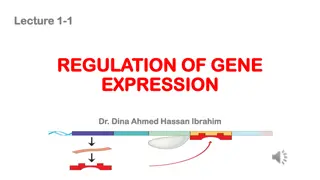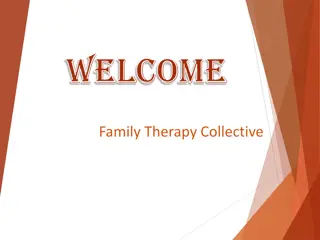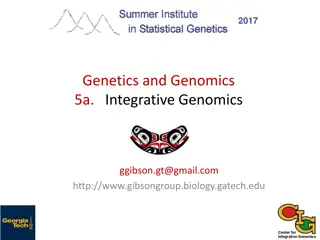Gene Therapy and Genome Editing Technology
This article provides insights into the status, regulatory considerations, and delivery methods of gene therapy and genome editing technologies. It discusses approved gene therapies in the US, human genome editing in clinical applications, and the regulatory authority of the FDA over gene therapy. The content covers a range of topics such as cell-based therapies, genome editing techniques, and the distinction between somatic and germline gene modifications. It highlights ongoing developments in the field and the current regulatory landscape governing genetic interventions in humans.
Download Presentation

Please find below an Image/Link to download the presentation.
The content on the website is provided AS IS for your information and personal use only. It may not be sold, licensed, or shared on other websites without obtaining consent from the author.If you encounter any issues during the download, it is possible that the publisher has removed the file from their server.
You are allowed to download the files provided on this website for personal or commercial use, subject to the condition that they are used lawfully. All files are the property of their respective owners.
The content on the website is provided AS IS for your information and personal use only. It may not be sold, licensed, or shared on other websites without obtaining consent from the author.
E N D
Presentation Transcript
Gene Therapy and Genome Editing Technology Peter Marks, MD, PhD National Press Foundation November 17, 2023
Outline Status of gene therapy and genome editing Regulatory considerations for genome editing Regulatory guidance for genome editing Facilitating product development www.fda.gov 2
Delivering Gene Therapy www.fda.gov 3
Describing Gene Therapy Cell-based or directly administered Hematopoietic stem Cell, T cell Viral or non-viral vectored Lentiviral, adeno-associated virus (AAV) vectors Lipid nanoparticles Genome edited TALENs, Meganucleases CRISPR-Cas9 (CRISPR = Clustered Regularly Interspaced Short Palindromic Repeats), base editors, prime editors www.fda.gov 4
U.S. Approved Gene Therapies Kymriah (2017) Yescarta (2017) Luxturna (2017) Zolgensma (2019) Tecartus (2020) Breyanzi (2021) Abecma (2021) Carvykti (2022) Zynteglo (2022) Skysona (2022) Hemgenix (2022) Adstiladrin (2022) Vyjuvek (2023) Elevidys (2023) Roctavian (2023) T cell Directly administered Stem cell www.fda.gov 5
Human Genome Editing in the Clinic Biologics License Application pending for what could be the 1st approved genome edited product Ex vivo genome-edited gene therapy for sickle cell disease (Exa-cel, formerly CTX001) Involves interrupting the gene that normally switches off fetal hemoglobin production in adults Fetal hemoglobin expressed at high levels counteracts the effect of sickle hemoglobin www.fda.gov 6
Authority Over Gene Therapy U.S. FDA regulates gene therapy including somatic and germline gene modifications in humans Includes modification of cells prior to administration and use of directly administered gene therapy vectors Only somatic cell gene therapy (non-heritable) is currently permitted in humans in the United States Congressional appropriations rider prohibits creation of heritable genetic modifications in humans www.fda.gov 7
Regulatory Considerations Nature of editing Ex vivo, in vivo Inactivation, insertion, modification Safety considerations Percentage of cleavage at on- and off-target sites Evaluation of the profile of insertions and deletions and types of mutations generated Benefit-risk analysis Monitoring after treatment www.fda.gov 8
Relevant Recent Guidance Human Gene Therapy Products Incorporating Human Genome Editing; Draft Guidance for Industry Considerations for product development General recommendations Manufacturing considerations Considerations for preclinical studies Considerations for clinical studies Human Gene Therapy Products Incorporating Human Genome Editing | FDA www.fda.gov 9
CRISPR-Cas Mediated Genome Editing From: Zhou et al. Trends in Biotechnology. 2023; 41:1000-1012 www.fda.gov 10
Platform Technologies Gene insert or guide RNA Vector Originator Product Offshoot Product 1 Offshoot Product 2 Offshoot Product 3 Premise In appropriate situations, non-clinical data and manufacturing information from one product may be able to be leveraged to another www.fda.gov 11
Omnibus Appropriations Act of 2023 Section 2503. Platform Technologies Requires FDA to create a designation program for platform technologies which are defined as technologies that have the potential to be incorporated in or used by more than one drug or biological product and are reasonably likely to make the drug development or manufacturing process and the review process more efficient. Requires FDA to issue guidance relating to the program. www.fda.gov 12
Section 2503. Platform Technologies Sponsors may also reference or rely upon data and information from a previous application for a drug or biological product that incorporates or uses the same platform technology Data must be submitted by the same sponsor or the sponsor relying on the data received permission from the sponsor who originally submitted the data www.fda.gov 13
Current Challenges Gene therapy is now at a critical juncture due to a combination of factors Manufacturing challenges Clinical development timelines Different global regulatory requirements www.fda.gov 14
Actions at Center for Biologics Advancing manufacturing technologies for cell and gene therapy through research Work to more clearly define the use of accelerated approval for gene therapy Exploring concurrent submission and product review with other regulatory authorities Operation Warp Speed for Rare Diseases communication pilot www.fda.gov 15
Criteria for Accelerated Approval Serious or life-threatening disease or condition Substantial evidence of effectiveness based on: Effect on a surrogate endpoint that is reasonably likely to predict clinical benefit, or Clinical endpoint that can be measured earlier than irreversible morbidity or mortality, that is reasonably likely to predict an effect on irreversible morbidity or mortality or other clinical benefit Taking into account severity, rarity, or prevalence of the condition and the availability or lack of alternative treatments Also takes into account residual uncertainty Section 506 (c) of the Food Drug and Cosmetic Act (21 U.S.C. 356(c)) www.fda.gov 16
Confirmatory Trials Post-marketing trials are routinely required to verify and describe clinical benefit when using accelerated approval By assessing clinical benefit, the goal of the confirmatory trial is to address the remaining uncertainty of the surrogate endpoint s relation to clinical benefit Because accelerated approval is inherently associated with greater residual uncertainty, some trials may not confirm clinical benefit www.fda.gov 17
Connecting Biomarkers with Gene Therapy Clinical Outcomes Human Observations Disease state is associated with protein levels above or below a certain range Certain protein levels are associated with disease absence or minimal disease Animal Models Disease model reflects aspects of human pathology Administration of therapy associated with achievement of a specific protein level ameliorates disease Demonstrate that equivalent protein levels can be achieved in humans affected by the disease www.fda.gov 18
Global Cooperation Produce document on potential regulatory framework for cell and gene therapies for low- and middle-income countries (ongoing at WHO) Convergence of regulatory approach in high income countries (? harmonization in the future) Discussion of concurrent collaborative review process for gene therapy (Project ORBIS model) www.fda.gov 19
Support for clinical Trials Advancing Rare disease Therapeutics (START) Pilot Goal is to further accelerate pace of development for products intended to address unmet medical needs in rare diseases or conditions likely to lead to significant disability or death in the first decade of life Three eligible products in the initial iteration to receive enhanced communications when selected for the pilot An initial meeting to review features of the pilot program Additional ad hoc interactions via email or teleconference on a scheduled and/or as needed basis as agreed upon by the sponsor and FDA www.fda.gov 20
START Pilot Timelines Federal Register Notice published September 29, 2023 Additional details: Federal Register :: Support for Clinical Trials Advancing Rare Disease Therapeutics Pilot Program; Program Announcement Requests to participate: January 2 to March 1, 2024 FDA will acknowledge receipt of requests within 14 days of receipt of request to participate in pilot FDA will notify sponsors of acceptance by May 30, 2024 www.fda.gov 21
Expedited Development Programs Fast Track Priority Review Accelerated Approval Breakthrough Therapy Regenerative Medicine Advanced Therapy These programs may be applicable to drugs or biologics intended to treat serious conditions www.fda.gov 22
Regenerative Medicine Advanced Therapy Designation (RMAT) Products must be intended for serious or life- threatening diseases or conditions Preliminary clinical evidence must indicate potential to address unmet medical needs Designated products are eligible as appropriate for priority review and accelerated approval Expanded options for fulfilling post approval commitments with accelerated approval www.fda.gov 23
INTERACT Program INitial Targeted Engagement for Regulatory Advice on CBER producTs To further encourage early interaction with sponsors and replace the pre-pre-IND meeting process across the Center regarding preclinical, manufacturing and, clinical development plans https://www.fda.gov/BiologicsBloodVaccines/ ResourcesforYou/Industry/ucm611501.htm www.fda.gov 24
CATT Meetings CBER Advanced Technology Team Provides an interactive mechanism for discussion of advanced technologies or platforms needed for the development of CBER-regulated biologics products CATT allows access to early and ongoing interactions with CBER before filing of a regulatory submission https://www.fda.gov/vaccines-blood-biologics/industry- biologics/cber-advanced-technologies-team-catt www.fda.gov 25
Summary FDA is committed to working with the community interested in developing therapies using genome editing and will engage with sponsors throughout the development lifecycle from concept through postmarket surveillance www.fda.gov 26























